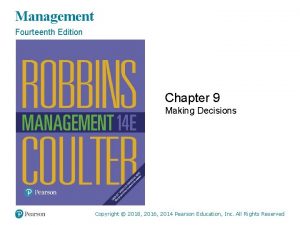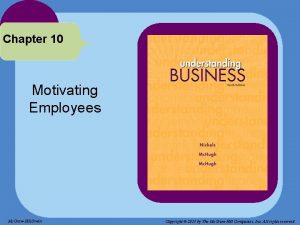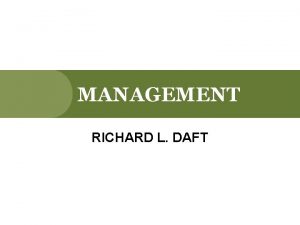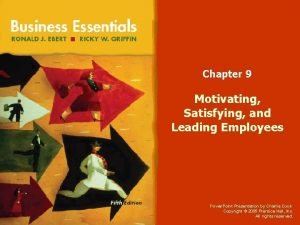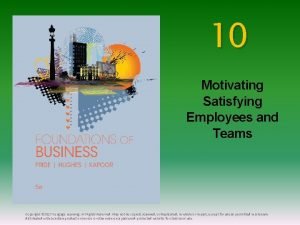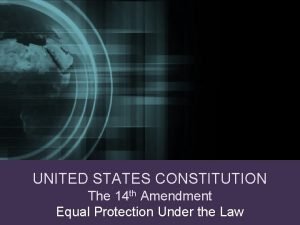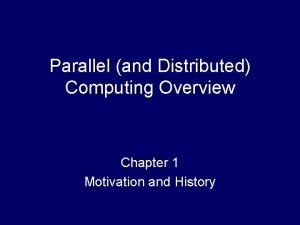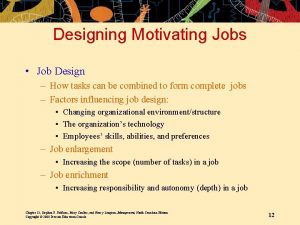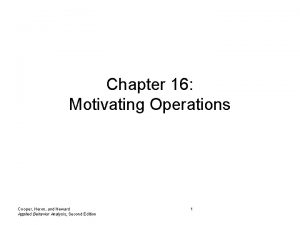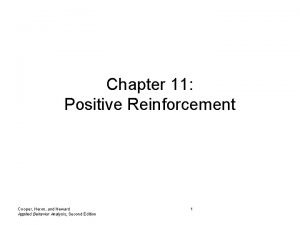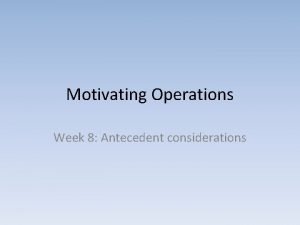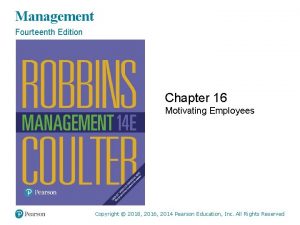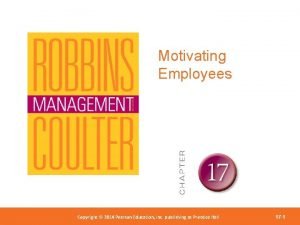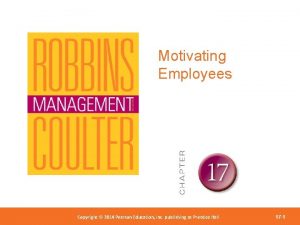Management Fourteenth Edition Chapter 16 Motivating Employees Copyright




















- Slides: 20

Management Fourteenth Edition Chapter 16 Motivating Employees Copyright © 2018, 2016, 2014 Pearson Education, Inc. All Rights Reserved

Learning Objectives 16. 1 Define motivation. 16. 2 Compare and contrast early theories of motivation. 16. 3 Compare and contrast contemporary theories of motivation. Develop your skills at motivating employees. 16. 4 Discuss current issues in motivation. Know how to identify what motivates you. Copyright © 2018, 2016, 2014 Pearson Education, Inc. All Rights Reserved

What is Motivation? • Motivation: the process by which a person’s reports are energized, directed, and sustained toward attaining a goal Copyright © 2018, 2016, 2014 Pearson Education, Inc. All Rights Reserved

Maslow’s Hierarchy of Needs Theory • Hierarchy of needs theory: Maslow’s theory that human needs—physiological, safety, social, esteem, and self-actualization—form a sort of hierarchy Copyright © 2018, 2016, 2014 Pearson Education, Inc. All Rights Reserved

Exhibit 16 -1 Maslow’s Hierarchy of Needs Exhibit 16 -1 shows the five levels of need in Maslow’s hierarchy. Copyright © 2018, 2016, 2014 Pearson Education, Inc. All Rights Reserved

Levels of Needs (1 of 2) • Physiological needs: a person’s needs for food, drink, shelter, sexual satisfaction, and other physical needs • Safety needs: a person’s needs for security and protection from physical and emotional harm • Social needs: a person’s needs for affection, belongingness, acceptance, and friendship Copyright © 2018, 2016, 2014 Pearson Education, Inc. All Rights Reserved

Levels of Needs (2 of 2) • Esteem needs: a person’s needs for internal factors such as self-respect, autonomy, and achievement, and external factors such as status, recognition, and attention • Self-actualization needs: a person’s need to become what he or she is capable of becoming Copyright © 2018, 2016, 2014 Pearson Education, Inc. All Rights Reserved

Mc. Gregor’s Theory X and Theory Y • Theory X: the assumption that employees dislike work, are lazy, avoid responsibility, and must be coerced to perform • Theory Y: the assumption that employees are creative, enjoy work, seek responsibility, and can exercise self-direction Copyright © 2018, 2016, 2014 Pearson Education, Inc. All Rights Reserved

Herzberg’s Two Factor Theory • Two factor theory (motivation-hygiene theory): the motivation theory that intrinsic factors are related to job satisfaction and motivation, whereas extrinsic factors are associated with job dissatisfaction Copyright © 2018, 2016, 2014 Pearson Education, Inc. All Rights Reserved

Exhibit 16 -2 Herzberg’s Two-Factor Theory Exhibit 16 -2 shows Herzberg’s findings. Copyright © 2018, 2016, 2014 Pearson Education, Inc. All Rights Reserved

Herzberg’s Two Factors • Hygiene factors: factors that eliminate job dissatisfaction, but don’t motivate • Motivators: factors that increase job satisfaction and motivation Copyright © 2018, 2016, 2014 Pearson Education, Inc. All Rights Reserved

Exhibit 16 -3 Contrasting Views of Satisfaction and Dissatisfaction As shown in Exhibit 16 -3, Herzberg proposed that a dual continuum existed: The opposite of “satisfaction” is “no satisfaction, ” and the opposite of “dissatisfaction” is “no dissatisfaction. ” Copyright © 2018, 2016, 2014 Pearson Education, Inc. All Rights Reserved

Three-Needs Theory (1 of 2) • Three-needs theory: the motivation theory that says three acquired (not innate) needs— achievement, power, and affiliation—are major motives in work • Need for achievement (n. Ach): the drive to succeed and excel in relation to a set of standards Copyright © 2018, 2016, 2014 Pearson Education, Inc. All Rights Reserved

Three-Needs Theory (2 of 2) • Need for power (n. Pow): the need to make others behave in a way that they would not have behaved otherwise • Need for affiliation(n. Aff): the desire for friendly and close interpersonal relationships Copyright © 2018, 2016, 2014 Pearson Education, Inc. All Rights Reserved

Goal-Setting Theories • Goal-setting theory: the proposition that specific goals increase performance and that diffcult goals, when accepted, result in higher performance than do easy goals • Self-efficacy: an individual’s belief that he or she is capable of performing a task Copyright © 2018, 2016, 2014 Pearson Education, Inc. All Rights Reserved

Reinforcement Theory • Reinforcement theory: theory that behavior is a function of its consequences • Reinforcers: consequences immediately following a behavior, which increase the probability that the behavior will be repeated Copyright © 2018, 2016, 2014 Pearson Education, Inc. All Rights Reserved

Equity Theory (1 of 2) • Equity theory: The theory that an employee compares his or her job’s input-outcomes ratio with that of relevant others and then corrects any inequity Copyright © 2018, 2016, 2014 Pearson Education, Inc. All Rights Reserved

Equity Theory (2 of 2) • Referents: the persons, systems, or selves against which individuals compare themselves to assess equity • Distributive justice: perceived fairness of the amount and allocation of rewards among individuals • Procedural justice: perceived fairness of the process used to determine the distribution of rewards Copyright © 2018, 2016, 2014 Pearson Education, Inc. All Rights Reserved

Exhibit 16 -7 Equity Theory Exhibit 16 -5 shows the Equity Theory. Copyright © 2018, 2016, 2014 Pearson Education, Inc. All Rights Reserved

Copyright © 2018, 2016, 2014 Pearson Education, Inc. All Rights Reserved
 Management fourteenth edition
Management fourteenth edition Motivating and satisfying employees and teams
Motivating and satisfying employees and teams Chapter 10 motivating and satisfying employees and teams
Chapter 10 motivating and satisfying employees and teams Norm althouse
Norm althouse Chapter 10 motivating employees
Chapter 10 motivating employees Chapter 10 motivating employees
Chapter 10 motivating employees Ways of motivating employees
Ways of motivating employees Motivating employees without money
Motivating employees without money Motivating and satisfying employees and teams
Motivating and satisfying employees and teams Motivating and satisfying employees and teams
Motivating and satisfying employees and teams Copyright
Copyright Fourteenth amendment
Fourteenth amendment Poem on summer vacation
Poem on summer vacation Mis chapter 6
Mis chapter 6 Zulily case study
Zulily case study Motivating parallelism
Motivating parallelism Motivating students to learn english
Motivating students to learn english Designing motivating jobs adalah
Designing motivating jobs adalah Examples of cmo-t
Examples of cmo-t Cooper heron heward
Cooper heron heward Motivating operations definition
Motivating operations definition
